The Cistercian Abbey of Rufford, Nottinghamshire was founded by the Norman Landholder Gilbert de Gant in 1146.
At Christmas in that year King Stephen confirmed Gilbert's grant of the lands from his estate at Rufford to the monks of Rievaulx (Holdsworth 1972).
Rufford Abbey is located on the east side of Sherwood Forest, in the 'High Forest'. It was founded near to the King's Highway to York, and would have been a familiar and welcome stop for travellers through the Forest.
The abbey was secluded; being surrounded by the open heaths and woodland of the High Forest.
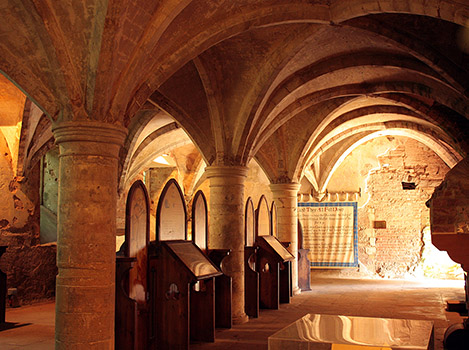
Picture: The undercroft at Rufford Abbey, Nottinghamshire.
The Cistercian movement of the late 12th century saw a massive re-
The Cistercians desired a life of seclusion-
In Sherwood Forest remoteness was available, but even here the foundation resulted in the removal of the villages of Rufford, Inkersall, Crately and Grimston-
The history of the lands received by Rufford Abbey from it's foundation through the middle ages is recorded in the 'Rufford Charters'. (Published by the Thoroton Society as: Holdsworth, C.J. 1972. Rufford Charters. Thoroton Society Record Series Vol. XXIX).
The charter lists the large endowments granted by De Gant in Rufford and in nearby villages.
It also discusses at length the rights of the Abbot of Rufford in relation to the forest law.
As well as these affairs of state and actions of the great and wealthy, the Charters also show how local people donated small pieces of property to the Abbey through the 12th-
Some of the records of these actions are in 'quitclaims' legal documents literally stating the quitting of any claims of ownership in order to pass the lands to the Abbey.
These 'quitclaims' not only show us how even the relatively less well off also wished to buy their way into heaven (imitating those above them), but it also gives us another glimpse into the landscape of the forest, its people, their trades and lives.
As well as quitclaims of land to the abbey, there are grants of land to rent from the abbey to people of the town.
This post will look at some of these documents relating to Nottingham and will show what we can learn about Medieval Nottingham and Sherwood Forest from examining them.
All names and entries are taken from Holdsworth 1972 and then interpreted below. Over time individual and related quitclaims will be examined through separate entries, but for now the following will give a flavour of the sources available:
Nottingham was divided in Medieval times into French and English Boroughs (see Medieval Nottingham entry for more details). These are listed as 'Burgo Franco' and 'Burgo Anglico' in a grant of a messuage in either borough by the Abbot of Rufford of 1236-
A lovely element of this grant is that part of the payment for one the messuages in question is with a pound of Cumin.
Spices were often used for payment in medieval times with 'peppercorn rent' being a literal form of payment.
The landscape of the town is also shown-
Stoney Street (the original Saxon highstreet of Nottingham) and still in existence today is mentioned frequently in the Charters as 'Stanstrete' in 1220, 'Stanestrete' in 1230 and again as 'Stonstret' in 1245-
Chapel Bar (the gate by the chapel) is listed in 1230 through the name Bartholomew de Barregate (Bartholomew of the street by the gate), and as Chapelbarre in 1285-
The Market Square is also mentioned in this last entry as 'forum Sabati' (the Saturday market).
These streets and features of the Nottingham landscape all still exist today and were all in place by at least the 13th century, they are shown below on John Speeds 1610 map of Nottingham for reference.
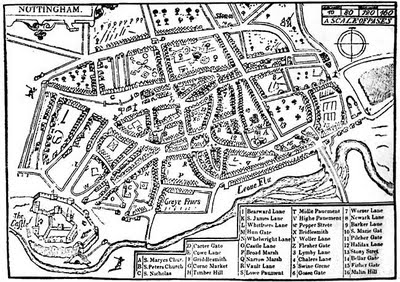
Picture: John Speeds Map of 1610 showing Chapel Bar, Market Square and Stoney Street.
A quitcalim from 1180 lists the highway from St. Mary's to the castle 'viam regiam que ducit ab ecclesia sancte Marie ad castellum'. Modern day High Pavement-
A 'Snapedale' is mentioned as ‘Snapedal' and is said in 1230-
Snapedale may mean 'boggy dale' from the etymology given for 'Snape wood' in Bulwell (EPSN 1940).
As well as the landscape we are introduced to the people and their trades. The entries list amongst others:
From...
1180 Hormus the baker,
a late 12th century Fulk the Smith (blacksmith)
1222-
1230-
1234-
1236 Gilbert le Spicer (perhaps the purveyor of the pound of Cumin!!)
from the mid 13th century a Thurkel le Marchuant (the merchant), Augustino le Clerico (Augustine the Clerk) and a Henrico le Talur (Henry the Tailor).
1285-
1412 William Sotyll, a Chaplain and a John Maysham, Butcher.
... to name but a few.
The names also occasionally show a mixture of old English and French.
With a Swain son of Thorald from 1299-
An earlier 'Henry son of Eyuolf' from a quitcalim of 1220-
The town was farily cosmopolitan with a Willelmi de Ypres (perhaps a wool trader from Belgium) listed in 1239, and a Heliam le Aleman (sadly not a purveyor of ales, but perhaps more interestingly a German-
Interestingly also mentioned is an 'Andrew Luterel' in 1222-
As can be seen the Rufford Charters offer a fantastic insight into the people and landscape of Nottingham in Medieval Sherwood Forest and if interpreted correctly the lives and works of the these people, and the landscape of the day can be pieced together from between the lines of the documents.
Names and trades all taken from Holdsworth, C.J. 1972. Rufford Charters. Thoroton Record Series Vol. XXIX.
(Andy Gaunt, first published 07/12/2011)
Click here for more ‘Stories from the Forest’…
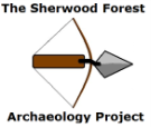


Community Archaeology Nottinghamshire, Community Archaeology Derbyshire, Community Archaeology Leicestershire, Community Archaeology East Midlands, Mercian Archaeological Services Community Archaeology for Nottinghamshire, Derbyshire, Sherwood Forest, Leicestershire and the East Midlands. Community Archaeology Nottinghamshire, Community Archaeology East Midlands, Community Archaeology Leicestershire. Archaeological

The Rufford Charters: landscape, people, trades and lives in medieval Sherwood Forest
Award Winners 2016
for "Engaging people in the heritage, history & archaeology of Sherwood Forest".
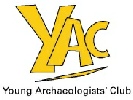
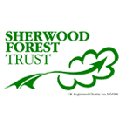



Some funders and partners:
World-









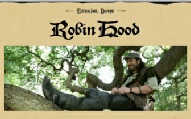

Mercian Archaeological Services CIC
Specialists in Community Archaeology, Public Involvement, Research & Training
Community Archaeology Nottinghamshire, Excavation, Research, Volunteering, Community Archaeology Derbyshire, Training, Social, Learning, Community Archaeology Leicestershire, Heritage, Involvement, Belonging, Knowledge sharing, Community Archaeology Lincolnshire, Topographic Survey, Talks and Presentations, Outreach, Archaeology Projects , Open Days, Schools, Finds Processing, Day Schools, Field Schools, Young People, Archaeology and History of Sherwood Forest, Pottery Research, Medieval, Roman, Prehistoric, Community Interest Company, Community Archaeology Nottinghamshire.
Community Archaeology in Nottinghamshire
Community Archaeology in Derbyshire
Community Archaeology in Leicestershire
Community Archaeology East Midlands
Community Archaeology in Lincolnshire
© Mercian Archaeological Services CIC 2013. Registered Business No. 08347842. All Rights Reserved.
The Future of Sherwood’s Past
Project page links:
-
-
-
-
-
-
-
-
The Sherwood Forest
National Nature Reserve Archaeology Survey
-
Long term Research at
King John’s Palace:
Ancient Royal Heart of Sherwood Forest
-
The Sherwood Forest Archaeology Training Fieldschool
-
“Scirwuda-
Ghost and Shadow woods of Sherwood Forest Project
-
Investigating Thynghowe Viking
Meeting Site
-
Searching for the
The Battle of Hatfield
-
-
Fieldswork at St Edwin’s Chapel
-
St Mary’s Norton-
-
Mapping Medieval Sherwood Forest
-
The Sherwood Forest LiDAR
Project
-
Warsop Old Hall
Archaeological Project
-
The Sherwood Villages Project:
Settlement Development in the Forest
-
-
-
Researching Edward IIs fortification at Clipstone Peel
-
-
-
-
The Cistercians of Rufford Project:
Settlement Development, Dynamics and Desertion.
-
Sherwood Forest Environmental Survey
-
World War II in Sherwood Forest -
-
World War I in Sherwood Forest -
-
About Medieval Sherwood Forest
-
Robin Hood and Sherwood Forest
-
-
-
-
-
-
-
-
-
-
-
-
Project page links:
-
-
-
-
-
-
-
-
The Sherwood Forest
National Nature Reserve Archaeology Survey
-
Long term Research at
King John’s Palace:
Ancient Royal Heart of Sherwood Forest
-
The Sherwood Forest Archaeology Training Fieldschool
-
“Scirwuda-
Ghost and Shadow woods of Sherwood Forest Project
-
Investigating Thynghowe Viking
Meeting Site
-
Searching for the
The Battle of Hatfield
-
-
Fieldswork at St Edwin’s Chapel
-
St Mary’s Norton-
-
Mapping Medieval Sherwood Forest
-
The Sherwood Forest LiDAR
Project
-
Warsop Old Hall
Archaeological Project
-
The Sherwood Villages Project:
Settlement Development in the Forest
-
-
-
Researching Edward IIs fortification at Clipstone Peel
-
-
-
-
The Cistercians of Rufford Project:
Settlement Development, Dynamics and Desertion.
-
Sherwood Forest Environmental Survey
-
World War II in Sherwood Forest -
-
World War I in Sherwood Forest -
-
About Medieval Sherwood Forest
-
Robin Hood and Sherwood Forest
-
-
-
-
-
-
-
-
-
-
-
-